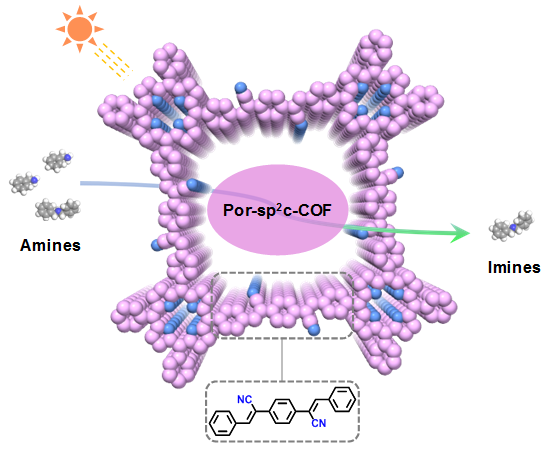
Covalent organic frameworks (COFs) represent a novel class of porous crystalline materials composed of light-weight elements and linked by strong covalent bonds. Featuring structural periodicity and inherent porosity, COFs have found interesting applications in molecular absorption and separation, catalysis, sensing, optoelectronics, energy storage, and other things. However, it should be mentioned that most of these reported COFs exhibit only moderate chemical stability. This bottleneck will greatly hinder their practical applications and, consequently, the design and synthesis of chemically stable COFs is highly desirable.
A new type of olefin-based COF, which is synthesized through the Knoevenagel condensation reaction, has gained increasing attention recently. The sp2 carbon linked COFs can be very stable owning to the C=C linkage. In addition, the sp2 carbon-conjugated skeletons can offer π conjugation along both the x and y directions, which may lead to a more effective way in transmitting π conjugation across the 2D lattice and thus enhance electron delocalization. In summary, the excellent stability and the fully sp2 carbon-conjugated skeletons of this 2D COF can provide an interesting platform for heterogeneous photocatalysis. However, due to the low reversibility of the formation of C=C bonds, the synthesis of sp2 carbon-linked COFs has been proven to be a big challenge and the application of 2D sp2 carbon-conjugated COFs in photocatalysis have been rarely explored.
Recently, a team led by Cheng Wang and Xianjun Lang in College of Chemistry and Molecular Sciences, reported the synthesis of a novel two-dimensional (2D) porphyrin-based sp2 carbon-conjugated COF (Por-sp2c-COF), which adopts an eclipsed AA stacking structure with a Brunauer—Emmett—Teller surface area of 689 m2 g-1. Owing to the C=C linkages, Por-sp2c-COF shows a high chemical stability under various conditions, even under harsh conditions such as 9M HCl and 9M NaOH solutions. Interestingly, Por-sp2c-COF can be used as a metal-free heterogeneous photocatalyst for the visible-light-induced aerobic oxidation of amines to imines. More importantly, in comparison to imine linked Por-COF, the inherent structure of Por-sp2c-COF equips it with several advantages as a photocatalyst, including reusability and high photocatalytic performance. This clearly demonstrates that sp2 carbon-linked 2D COFs can provide an interesting platform for heterogeneous photocatalysis.
Article link: https://onlinelibrary.wiley.com/doi/10.1002/anie.201902543
Group website: http://chengwang.whu.edu.cn
